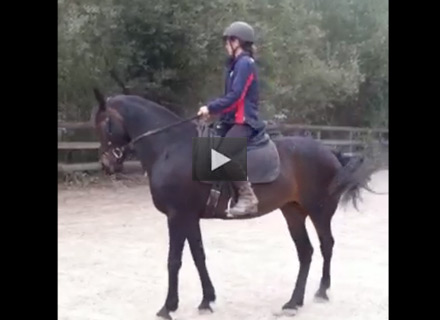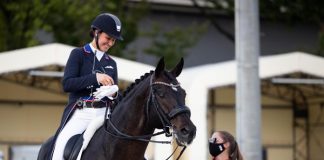It’s the kind of exercise that we never leave behind, no matter how simple it seems until you break down its parts, or aim for total accuracy in execution. For one thing, riding a good turn on the forehand is no easy task. But more importantly, the physical benefits from this simple maneuver for the horse are numerous. From a physiological standpoint, riding this exercise several times daily might be one of the most efficient ways to improve your horse. Let’s take a look why, plus review some tips for your own routine.
The horse’s hindquarter musculature—those big powerful muscles including the gluteals, the biceps femoris, and the hamstring group to name a few—are all interconnected through a sheet of connective tissue called fascia. What this means is that when any single muscle builds up tension or restriction, it limits the other muscles because of this connective web that is now crimped. Tension build-up is a natural result of exercise training, but can be kept at bay with maneuvers that release restriction before it escalates. Certain maneuvers are able to stretch the rigidity from those big hard-to-manipulate muscles. Getting a horse to step sideways with his hind legs crossing over is one of the best ways to apply traction to the hindquarter fascia and thereby interconnecting muscles. As the hind leg steps under, it pulls downward on that fascia to stretch and then immediately release blockages in the hind-end muscles, step after step.
Given that turn on the forehand is a stationary movement, rather than walking the horse forward while also stepping him sideways, it is an efficient way to control the cross-over action of the hind legs. In addition to the stretching benefits, the adduction of a hind leg required for this maneuver engages the horse’s abdominal muscle group. These muscles, which run the length of his body from his pelvis all the way up through his throat and to his tongue, play a crucial role in the horse’s ability to move with good posture and form. Almost every horse will begin to chew softly on the bit as soon as a turn on the forehand is initiated. Now that you understand how his tongue and neck muscles connect to his pelvis and inner thighs muscles, it will be no mystery why!
 To reiterate, the turn on the forehand simultaneously loosens both ends of the horse, his hindquarters and his neck and jaw. That is what I consider a highly effective training tool. It is one that should be part of your daily toolbox, not an elementary schooling exercise that you move past once mastered. Here is how to ride it well:
To reiterate, the turn on the forehand simultaneously loosens both ends of the horse, his hindquarters and his neck and jaw. That is what I consider a highly effective training tool. It is one that should be part of your daily toolbox, not an elementary schooling exercise that you move past once mastered. Here is how to ride it well:
- Begin in a lively working walk with a soft, but connected rein contact. You should aim for a few ounces, not pounds, of positive tension in your reins.
- Look ahead and pick a marker in the arena somewhere in front of you.
- Ride straight towards your marker.
- When you are about six meters away from your marker, ask your horse to walk with shortened steps. Initially he might slow down slightly as you ask him to shorten his strides; this is fine.
- Prepare these shortened steps as you would if you were asking your horse to halt, except keep him moving a little forward instead of stopping.
- Then, ask him to bend to the left at his poll and simultaneously apply rhythmic on-off pressure with your left leg to make a turn on the forehand.
- His front feet should march up and down in one place. His hind-end should swing smoothly, unhurriedly around his front feet. Ideally, his left hind leg will cross all the way over his right hind leg, forming an “x” if viewed from behind.
Liked this article? Here are others you’ll love:
Leg Yield Troubleshooting
Dressage Challenge Part I
Ask the Expert: Fix Falling in






Great advice.